Miramichi Fishing Report for Thursday, April 17, 2014
Welcome to another year of Doug’s Fishing Report. Although by the calendar, opening day has come and gone, very few anglers were able to get lines in the water. Most rivers are still full of ice and the snow is blocking most roads and trails that lead to the water. There were a few patches of open water, but none safe to launch a boat. There was ice movement in the Doaktown area on Wednesday, but by most reckonings, it will be at least another week, or perhaps even longer, before conditions improve enough to safely head out.
I’m not sure whom to give credit for the following, but I received it on e-mail and it fits the situation very well
It’s been a cold , cold winter but – we are ready…

REMINDERS:
Anglers must use single barbless hooks or ones with the barb pinched back to fish for spring salmon. So check your fly box to make sure all hooks are prepared before you hit the water. Putting on a barbed hook by mistake could be very costly in terms of fines, loss of equipment and angling privileges.
Get your license at Service NB Offices (Remember they are closed Saturday and Sunday) or your local fly shop or convenience store that sells them. Only Crown Reserve licenses are available at DNR offices this year.
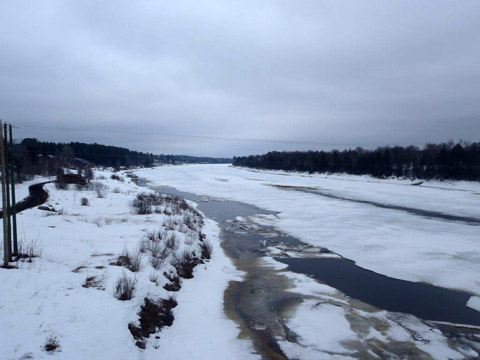
Quarryville, late Monday afternoon April 14
Moncton, NB – March 20, 2014 – Fisheries and Oceans Canada wishes to inform the public of important changes in the management of Atlantic salmon recreational angling in New Brunswick.
The management changes are the following:
- The expansion of the catch and release measures on the Northwest Miramichi River system;From June 1 until July 31, 2014, catch and release will be mandatory in the Northwest Miramichi River system and its tributaries upstream from the Red Bank Bridge on Route 425.For the rest of the season, the following waters will remain catch and release:
- Portions of Little Southwest Miramichi and its tributaries upstream from Catamaran Brook;
- The portion of Northwest Miramichi River and its tributaries upstream from Little River;
- The portion of both the north and south branches of the Big Sevogle River and their tributaries upstream from but not including Square Forks.
- The yearly fishing quota for grilse will be reduced from eight to four in the Atlantic salmon recreational fishery (reduction of tags);
- The daily catch and retain quota for grilse will be reduced from two to one in the Salmon Fishing Area (SFA) 15. SFA 15 comprises the area from Restigouche River up to, but excluding the Tabusintac River. The measure does not apply to boundary waters next to the Province of Quebec.
- The Nigadoo River, from the bridge on Route 134 upstream to and including Haché Pool will be fly only waters beginning on July 15 until the end of the angling season;
- The Saint John River, 100m upstream and 100m downstream from the mouth of Muniac Stream, and 350m upstream from its confluence with the Saint John River will be closed to all angling after July 1.
The management measures announced today will help with the efforts of achieving conservation objectives for Atlantic salmon in New Brunswick.
To report any suspicious fishing activity, please contact the nearest Fisheries and Oceans Canada office or to call Crime Stoppers at 1-800-222-8477.
For more information on this fishery, please contact:
Pierre Bélanger
Senior Advisor, Recreational Fisheries
Fisheries and Oceans Canada
Moncton, NB
(506) 851-2002
For media inquiries, please contact:
Steve Hachey
Communications Officer
Fisheries and Oceans Canada
Moncton, NB
(506) 851-7045
There area lot of deer around the roads this time of year, so take a bit more time and drive a bit slower to make sure you arrive and depart for home safely.
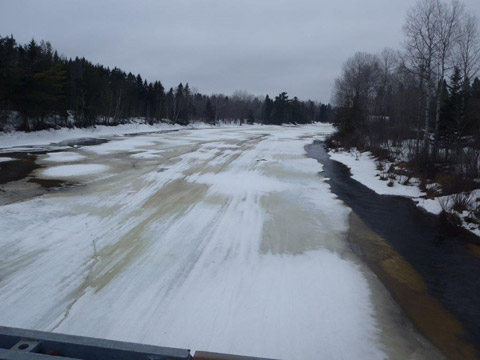
Bailey Bridge at Pineville looking up the Renous River
ANY FINANCIAL CONTRIBUTIONS TOWARD HELPING WITH THIS COLUMN ARE GREATLY APPRECIATED. Click here to donate now. A SPECIAL THANKS to all who made contributions last season.
If you would like to sponsor this column, give us a call at (506) 352-7668 or email .
PREPARATIONS FOR Getting back on the water
First, buy a license. You don’t need to be getting ready the night before and suddenly realize “I don’t have my license”. Next, be sure to have at least one tag in your possession. Most anglers do not keep black salmon and therefore do not think they need to have a tag, but the law says that anglers must have a tag if angling for salmon.
With some time before opening day, it’s nice to get into the mood with a hands-on look at equipment. George Routledge of George’s Fly Shop in Renous had the following suggestions. First check the reel. Most probably have forgotten to look after it last fall when angling was over. Routledge suggested giving it a good cleaning and dusting, along with a coat of light oil. He prefers light heat resistant oil like 3-in1, Singer sewing machine oil or a gun-oil rather than grease, as grease tends to harden. This oiling should take place several times throughout the season for best results.
Next the fly line. For those new to angling for black salmon, a sinking line is recommended, as opposed to the floating line used during summer. Unlike bright salmon, blacks tend to rest in deeper water as they drop down, choosing slack water, eddies, and deeper holes out of the current.
For shore-fishing, Routledge suggested a fast sinking (no. 5 sink) for early fishing, and later in the season a no. 2 or 3. Sinking lines will range from $13.00 to $45.00 depending on brand and quality.
Old lines must be checked for cuts and cracks, and cleaned and greased with silicone. Check where it is tied to the backing to see if all is in good shape. Lacquer covering the joint must be smooth and uncracked. Backing should also be checked for rot from oil or fly dope. Failure could ruin a day on the river if it breaks on the first fish.
Routledge suggests 12 to 15 pound-test leader, averaging three to five feet in length. He recommends new leader each year, especially if one prefers no. 6 or 8.
“For the price of a new leader, losing a big fish is not worth it. Not only the fish, but the story also gets away,” said Routledge.
The rod should be examined, paying attention to the guides. Make sure they’re tight and the lashing isn’t frayed. If so, repair them or take them to a tackle shop. Before putting a rod together, add oil or silicone so sections will come apart easily. A crude method is to rub the male end along the side of your nose. This will often be enough. Check the reel seat to make sure it is functioning and tight. You do not want it to plop into the water with a fish on. Waders should be examined for cracks and leaks with some goop applied where necessary.
Now’s the time to do some re-organizing. Put streamer flies into one box, hairwings in another, dryflies and bombers in another and maybe, if you’re like me, carrying more flies than I’ll ever use, the few most often used in another box.
Sharpen hooks. A dull hook may slip and gouge a fish you’re planning to release anyway. A whetstone or special sharpener will put hooks into top form. Pinching the barb or barbless hooks for Blacks is mandatory. It causes less harm to fish.
Check to see if new streamers are needed. Then buy them, or head for the tying bench. A few nights with a friend, a few stories (never lies, of course!) will certainly set the mood. Get or tie big streamers in the 5/0 and 3/0 ranges. Then make sure the streamer box goes back into the vest and that the barbs are pinched.
With the excitement of getting back onto the river, we might tend to be over anxious, forgetting the common sense needed for safe angling. One mistake can be too many given conditions and temperatures this time of year. Currents are extremely strong as rivers are flooded with spring run-off and ice, and the water is COLD. A dip means hypothermia in literally minutes. It may be too late for a second chance.
First, I’ll address “shore angling.” Many times spring ice will completely cover the shore after the river opens making it necessary to crawl over it. This can produce nasty falls. The ice can also be soft and give way causing twisted knees.
If one slips, he may end up in fast current and be gone, especially with heavy clothes on. Most shore anglers never think to wear a life jacket. Even if he manages to grab on to something, equipment may be lost as well.
Even if one does successfully navigate over bank ice, he has to still keep an eye on it. Melting may collapse the ice sending it sliding into the river behind you. If you aren’t careful it can trap you knocking you into the water.
Wading this time of year is very dangerous. Even what was familiar ground becomes strange in spring high current. One step too many can throw an angler off balance in heavy current, and getting over ice usually means there are no bushes handy enough to grab.
Even if the shore is clear and one knows the ground to be level, he still has to be checking up river for ice which may have slipped into the water.
Of course, one should never venture forth alone. If anything happens, you are on your own.
Now for boats. Common sense should prevail. A stupid move could be deadly in spring water. First, make sure the “PLUG” for draining the boat is securely in place before putting the craft into the water.
The anchor should always be heavy enough to hold in strong current. A heavy chain link is recommended but attach it by a rope. Most do this, but some may try a cable or chain. If the boat is anchored and up-river ice suddenly comes down, there may be no time to pull anchor.
If ice hits the anchor rope, it will sink the boat and anglers will likely be caught under a floating raft of ice. Using a rope enables one to cut it in an emergency. Therefore, have a sharp knife HANDY.
Some boats use two anchors which most consider dangerous. Make sure the bow is pointing into the current when the anchor(s) is dropped. A side-ways boat is a sure invitation to flip.
Always follow the recommended number for the boat. Don’t cram five into a boat built for three. Be careful of having too much weight at the front of the boat when the anchor is dropped. When it grabs, the front will naturally take a dip. Too much weight in front may mean anglers taking a dip.
A bailing can on board is a smart idea, not only for when a leak occurs, but when heading up river at a pretty good clip, there’s often a lot of spray that accumulates in the boat. This will be enough to wet lunches, ruin cameras or other materials placed on the floor.
Every boat must also have at least an oar or paddle in case the motor quits. A pair of either is even better as one person trying to guide a boat in fast water may lead you in circles. A set pole to push off shore is also a good idea.
When starting the engine, make sure everyone is ready and seated. A sudden start can knock a person off balance. When moving around in the boat, be careful making certain not everyone moves in one direction at the same time. Have life jackets for each person and WEAR THEM.
Even a spare fuel can is not a bad idea. Sometimes traveling up and down the river you may hit heavier water than expected and use more fuel than anticipated. Always check and fill the tank before leaving. It is also wise to have an extra plug and plug wrench along with a few basic tools.
Should the motor fail, a tow rope makes life a lot easier should another angler offer help and to throw to someone overboard. A whistle and water-proof flash light are required items.
When approaching another boat, take a wide berth and slow down so as not to cause a wake which could rock another boat. If someone is anchored, don’t stop too close. When angling for spring salmon, many fishermen let out tremendous amounts of line and then reel in. You don’t want your line in someone else’s territory.
A neat idea for measuring the length of fish is to have a scale marked along the top sides of the boat. This way length can be taken quickly and the fish released, or better still the angler can gauge the length with a quick look with the fish still in the water. Some have a scale marked on the middle seat of the boat where the fish can be laid quickly and released. This saves time and fumbling for a measuring tape and often prevents a good tape from getting wet or bent. Remember, no salmon can be kept even in spring. Anything over 63 cm must go back.
A pocket journal is a good way to record a day’s fishing. It’s always nice to look back and know exactly who caught what. This can settle friendly arguments, should anyone’s imagination go adrift.
Dress warmly in layers and have a rain coat. You can always take it off, but without enough clothes, it can be a miserable day should a cool wind come up. A thermos of coffee or tea can be a welcome treat. Don’t forget to have the trailer in good working order (tires, lights etc.) inspected and registered.
Common sense and a few preparations can make for an enjoyable day “on the water.”
STRIPED BASS UPDATE
There was a public meeting with close to 200 anglers present at the Lion’s Center in Miramichi on Sunday April 6. DFO, who did not attend the meeting, had announced changes for this coming year a day prior to the meeting.
New for 2014, the Department will authorize additional days in the retention fishery. From May 1 to 21, from August 1 to 21, and from September 24 to 30, 2014, anglers will be able to retain a maximum of one striped bass per day and will be prohibited from possessing more than one striped bass at any given time. Outside of these ‘retention’ periods, all striped bass caught must be released immediately in a matter that causes the least harm to the fish.
Also new for this year, the size window for the retention fishery has been increased and established at a minimal length of 50 cm and at a maximum length of 65 cm. The length is measured in a straight line from the tip of the nose to the tip of the tail (total length).
In 2014, the use of a non-offset barbless circle hook is now mandatory when bait is used while fishing for striped bass in tidal waters. This will help to reduce the mortality of fish that have been released.
Same as in 2013, the recreational fishing season will begin two hours before sunrise and end two hours after sunset of each day, from May 1 to September 30, 2014.
On Tuesday April 15, a group of selected representatives from the Sunday meeting met with Miramichi City Council. The council supported the group’s efforts to bring about change, and will send a formal letter to both MP Tilly Gordon and Fisheries Minister Gail Shea.
For those of you whom are interested in a change to the consultation, advisory and decision making process to actually include the general public as a voice, please take a moment to download or print this survey/ petition form off. Have it signed and dated by yourself and as many people that you know will agree that a CHANGE is necessary. You can send it directly to or courier as many as you like to:
Honorable Gail Shea (Minister of Fisheries and Oceans)
House of Commons
Ottawa, Ontario
Canada
K1A 0A6
Phone number is (613)992-9223
You may also send Minister Shea a message via e-mail at:
Gail Shea(Min.DFO) <>
So far there has been approximately 500 couriered directly to her office in Ottawa from April 7/14 to April 15/14.
Last night, April 14/14, as per our request, Miramichi City Council had voted unanimously to write a letter to Minister Shea as well as MP Tilly O’Neill Gordon to request that DFO implement a better management plan, more transparency and involve the general public (which includes the individual recreational angler) in the consultation and decision making process.
Thank You all,
David Whyte
MVHS Fly Fishing & Sportsman Show
On Friday and Saturday April 11-12 Ashley Hallihan’s Miramichi Valley High Fly Tying Club hosted 170 students on Friday with sessions on a variety of tying methods and casting techniques. Saturday was open to the public with a good number of tyers, authors, exhibiters, Miramichi Search & Rescue and DNRA on hand. This is the second year for their Miramichi Fly Fishing & Sportsman Show and it continues to grow.
Thought for the Week: “All living waters whisper individually to us. Call it the Ancestral Whisper, and it is as real as anything else we adorn with capital letters and choose to believe.” Howell Raines in his Fly Fishing through the Midlife Crisis
Atlantic Salmon Federation News
Tuesday, April 15, 2014
ASF RIVERNOTES Begins Publication for the Season
~~~~~~~~~~~~~~~~~~~~~~~~~~~~~~~~~~~~~~~~~~~~~~~~
With April 15 here, ASF RIVERNOTES begins its regular survey of what is happening on the salmon rivers of North America and beyond. Besides the Penobscot, this week’s story is all about ice.
http://atlanticsalmonfederation.org/rivernotes/
NB Salmon Council Fears Crown Lands Policy Will Affect Wild Salmon
~~~~~~~~~~~~~~~~~~~~~~~~~~~~~~~~~~~~~~~~~~~~~~~~
The NB Government is intent on loosening rules for cutting on Crown Lands, but the NB Salmon Council raises concerns for the rivers and Atlantic salmon runs.
http://asf.ca/nb-salmon-council-fears-crown-lands-policy-will-harm-salmon.html
Obama Appoints Two Excellent Commissioners to NASCO
~~~~~~~~~~~~~~~~~~~~~~~~~~~~~~~~~~~~~~~~~~~~~~~~
NASCO is the “United Nations” for Atlantic salmon countries, and President Obama has appointed two US commissioners who are well versed in the issues of Atlantic salmon. The appointments made news as far away as Argentina – and Seattle.
Pat Kelliher
http://asf.ca/obama-appoints-pat-keliher-as-commissioner-to-nasco.html
Stephen Gephard
http://asf.ca/stephen-gephard-appointed-to-nasco.html
SAEN Offers $500 Reward for Poaching Convictions
~~~~~~~~~~~~~~~~~~~~~~~~~~~~~~~~~~~~~~~~~~~~~~~~
In Newfoundland and Labrador, SAEN is offering $500 Reward for information that results in conviction of poachers.
http://asf.ca/reward-offered-in-nl-for-info-on-poaching.html
Trophy Catch and Release Angling
~~~~~~~~~~~~~~~~~~~~~~~~~~~~~~~~~~~~~~~~~~~~~~~~
In NL and LB, SAEN is also sponsoring a Live Release Trophy involving more than Atlantic salmon. Check out details:
http://asf.ca/trophy-catch-and-release-angler.html
ASF’s Montreal Benefactor Dinner – with Dr. Fred Whoriskey Jr.
~~~~~~~~~~~~~~~~~~~~~~~~~~~~~~~~~~~~~~~~~~~~~~~~
ASF is presenting on May 7 a very special Benefactor’s Dinner that will include Dr. Fred Whoriskey Jr., Director of the Ocean Tracking Network, and formerly ASF VP Research and Environment. Check out details below, and download .pdf at site.
http://asf.ca/montreal-dinner.html
~~~~~~~~~~~~~~~~~~~~~~~~~~~~~~~~~~~~~~~~~~~~~~~~
To keep track of breaking news on wild Atlantic salmon, use the Atlantic Salmon Federation’s presence on Facebook. Log in, search for Atlantic Salmon Federation, and click “like”.
This story is too good not to share!

Julian Furlaga with ASF President Bill Taylor
What does ASF mean to you? That’s the question we put to 9-year old Julian Furlaga. Julian recently attended an ASF fundraising dinner in Moncton, NB where he became fast friends with ASF President Bill Taylor. Julian donated one if his amazing flies for the Moncton auction which helped to raise nearly $300! Way to go Julian! Here is the letter he wrote to ASF recently:
“My Name is Julian Furlaga I live in New Brunswick Canada and I am 9 years old. I tied my first fly at the Dieppe Fly Fishing Forum in 2012. Since then I am a member of the Dieppe Fly Tying Club, which is where I learned to tie many different flies over the last 2 years. Maybe a year ago I started to tie Classic Salmon Flies which is now my passion. I am very lucky to be surrounded by some of the best fly tyers in the world who live here in the Maritimes. I have been very lucky to be able to sit with them and have them teach me Classic Fly tying. I love the challenge of tying Classic Flies and the beauty of them. I would like to Thank all the local tyers and from around the world who have helped and supported me. My good friend Davie McPhail in Scotland for making all the awesome videos that helped me get started tying. Thank you to Jerome Molly for teaching me my favorite fly the Black Dog which was donated to the ASF to raise funds for saving the salmon in the rivers. Most of all a special Thank you to Bryant Freeman my good friend who I spend many days with at his shop learning to tie many different flies allowing me to go through his stuff and use it. I am lucky to have my Dad who takes the time to take me everywhere and get me things I need to tie my flies and to my Mom for putting up with my fur feathers and hooks all over the house. I would like to Thank the Atlantic Salmon Federation for the hard work they do to protect the salmon and their habitat around the world so that we may enjoy fishing for them for many years to come. Thank you, Julian.”
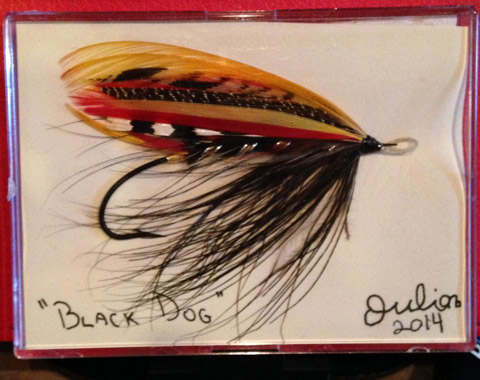
Julian’s Fly
Email:
Here’s a few pics of the ice jams and flooding around Doaktown. There won’t be much fishing for a few days as there is still a ton of ice to move out of the system yet. Thanks!
Derek Munn
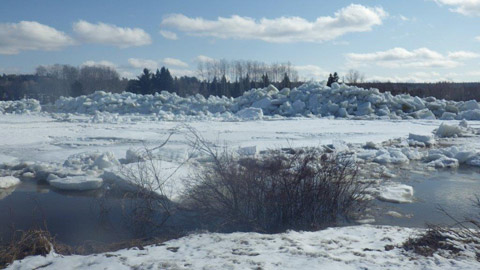
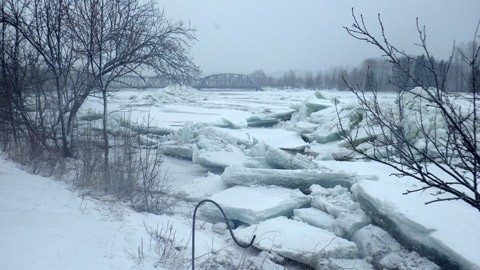
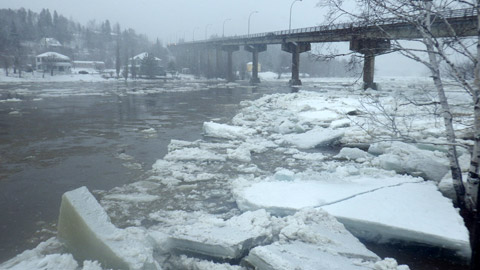
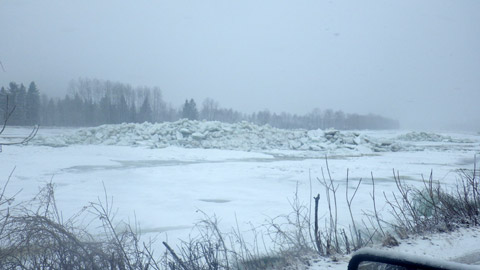
Until next week
TIGHT LINES
Doug
Giv’er Miramichi is about “What’s up, what’s new, what’s happening”. We are focused on building people up, supporting one another and celebrating our successes.
